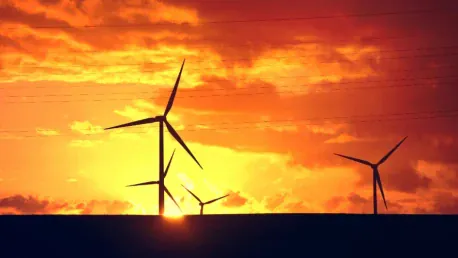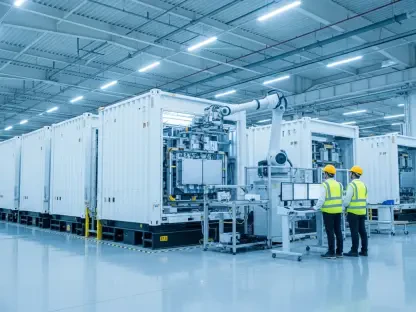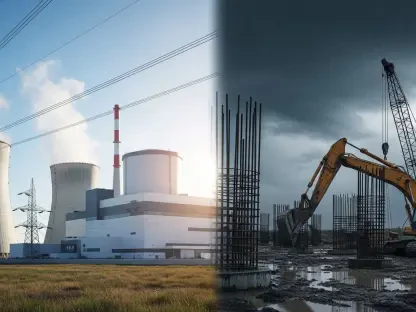Canada is embarking on an ambitious journey to transition its electricity grid to net-zero emissions by 2050, a plan that involves integrating clean, renewable energy sources, implementing robust government policies, and engaging various stakeholders, including Indigenous communities, to reduce greenhouse gas (GHG) emissions while ensuring reliable and affordable electricity for all Canadians. This comprehensive strategy aims to not only combat climate change but also spearhead economic growth, attracting significant industry investments and creating good-paying jobs across the nation.
The Significance of Clean Electricity
Electricity is a cornerstone of modern life and economic development, supplying families and businesses with the energy needed for heating, transportation, and industrial uses. As Canada grows and shifts away from fossil fuels, the demand for electricity will rise significantly. Clean electricity systems, utilizing hydropower, wind, solar, and nuclear energy, are essential for reducing GHG emissions and achieving a net-zero economy by 2050. This transition is not only environmentally crucial but also presents a unique opportunity for economic growth, driving investments and creating well-paying jobs across various sectors. Furthermore, the shift to clean electricity promises to bring significant savings compared to traditional fossil fuels, reducing energy costs for families and positively impacting their disposable incomes.
The move towards clean electricity isn’t just about emission reductions; it’s also about ensuring a sustainable and prosperous future for all Canadians. By investing in renewable energy sources, the country can mitigate the impacts of climate change while promoting long-term economic stability. As the cost of renewable technologies continues to decrease, the transition becomes more feasible and financially attractive, not only supporting environmental goals but also securing a competitive edge in the global market. Ultimately, clean electricity is at the heart of Canada’s vision for a sustainable and prosperous future, balancing environmental priorities with economic viability.
Powering Canada’s Future
The Government of Canada has outlined its strategy in “Powering Canada’s Future: A Clean Electricity Strategy,” focusing on developing clean electricity systems to meet future demand, drive growth, and ensure competitiveness. This comprehensive plan includes significant investments and balanced policies aimed at building new, clean electricity infrastructure across the country. Central to the strategy is the meaningful participation and leadership of Indigenous peoples, whose involvement is crucial in creating more clean electricity and ensuring the strategy’s success.
This strategy also seeks to integrate emerging technologies and innovative approaches to electricity generation and distribution. By fostering collaboration between government entities, industry players, and communities, Canada aims to create a resilient and adaptive electricity grid capable of responding to evolving energy demands and environmental challenges. The strategy emphasizes the importance of a holistic approach, ensuring that economic, social, and environmental objectives are balanced and pursued in tandem to achieve a sustainable and inclusive energy future.
Clean Electricity Regulations
In December 2024, Canada finalized the Clean Electricity Regulations, marking a pivotal step towards achieving net-zero goals. These regulations set strict limits on carbon dioxide emissions from nearly all fossil-fuel-based electricity generation units starting in 2035, providing electricity providers with the time needed to make necessary investments and adjustments. The regulations are guided by three core principles: enabling significant GHG reductions to achieve a net-zero electricity grid by 2050, maintaining affordability for Canadians and businesses, and ensuring grid reliability to support the growing electricity needs of the country.
These regulations establish a clear framework for transitioning to a cleaner energy future, setting stringent benchmarks and timelines for the reduction of emissions while allowing for innovative and flexible solutions. The regulations are technology-neutral, giving decision-makers the freedom to adopt the best possible technologies and approaches for their specific circumstances. This flexibility is crucial in fostering innovation and ensuring that the most effective and efficient solutions are implemented to achieve the net-zero target while keeping energy costs manageable.
Extensive Consultations
The development of the Clean Electricity Regulations involved extensive consultations beginning in March 2022, engaging stakeholders such as utility companies, governments, Indigenous groups, industry associations, and environmental organizations. These consultations ensured the regulations reflected diverse circumstances across Canada, incorporating insights and feedback from various regions and communities to create a comprehensive and inclusive regulatory framework. The consultative process was essential in addressing the unique challenges and opportunities faced by different stakeholders, fostering a sense of shared responsibility and collaboration towards the common goal of a net-zero electricity grid.
The inclusive nature of the consultations also helped to identify potential barriers and develop tailored solutions that accommodate the needs of different sectors and communities. This approach ensured that the regulations are not only effective in reducing emissions but also practical and achievable, offering a balanced approach that takes into account the diverse realities of Canada’s electricity landscape. By incorporating a broad range of perspectives and expertise, the regulations are better positioned to drive meaningful and sustained progress toward a cleaner and more sustainable energy future.
Emission Limits and Flexibilities
Starting in 2035, the regulations will impose annual emission limits on carbon dioxide pollution from most fossil-fuel-based electricity generation units, ensuring that Canada remains on track to achieve its net-zero goals. The regulations are designed to be technology-neutral, allowing decision-makers to choose the best solutions for their specific situations, thereby promoting innovation and flexibility in achieving emission reductions. Operators will have the option to exceed their annual emissions limits by remitting equivalent greenhouse gas offset credits, providing an additional compliance mechanism while maintaining the overall integrity of the emission reduction targets.
The regulations also include provisions for unused credits, allowing them to be banked for future use or pooled between units under the same operator. This flexibility is essential in accommodating the dynamic nature of electricity generation and consumption, offering operators the ability to plan and manage their emissions more effectively. Furthermore, the regulations incorporate specific flexibilities for emergency responses, cogeneration units, and biomass combustion, ensuring that critical energy needs can be met without compromising the overarching emission reduction objectives. This balanced approach is designed to maintain grid reliability and affordability while driving significant GHG reductions.
Ensuring Reliability and Affordability
A reliable electricity supply that can withstand sudden disruptions or demand increases is crucial to Canada’s economic and daily activities. The clean electricity regulations are designed to support a stable and dependable grid across the country, ensuring that the transition to clean energy does not compromise the reliability of the electricity supply. The regulations set clear guidelines for maintaining grid stability while driving the adoption of renewable energy sources, balancing the need for reliability with the imperative of reducing emissions.
The transition to clean electricity also holds the potential for significant cost savings for households, reducing their reliance on volatile fossil fuel prices. Technologies such as electric cars and heat pumps can save families hundreds of dollars each month, offering both environmental and financial benefits. By fostering the adoption of these technologies and supporting energy-efficient practices, the regulations aim to create a more sustainable and cost-effective energy system for all Canadians. This dual focus on reliability and affordability is central to ensuring that the transition to net-zero is not only environmentally responsible but also economically viable and socially inclusive.
Reducing Emissions
Reducing emissions is a critical step in mitigating climate change and promoting environmental sustainability. Efforts to decrease emissions can involve various strategies, such as adopting renewable energy sources, increasing energy efficiency, and implementing stricter regulations on industrial pollution. By working together as a global community, significant progress can be made in reducing the carbon footprint and protecting the planet for future generations.
Canada’s electricity sector has already made significant strides in reducing emissions, with about 85% of the country’s electricity coming from renewable and non-emitting sources. The new regulations aim to further decrease GHG emissions by 2050, preventing a substantial rise in emissions despite increased electricity generation. This ambitious target reflects Canada’s commitment to playing a leading role in the global fight against climate change, setting an example for other nations to follow. The regulations embody a clear and compelling vision for a sustainable energy future, driving the transition towards a cleaner, healthier, and more resilient electricity system.
The continued expansion and integration of renewable energy technologies are central to achieving these emission reduction goals. As provinces and territories adopt more renewable technologies, the cost of these technologies continues to decrease, making them increasingly viable and attractive options for electricity generation. The regulations will support this transition by encouraging the adoption of clean energy and phasing out fossil fuel dependency, positioning Canada as a global leader in sustainable energy innovation. By leveraging the country’s abundant natural resources and fostering collaborative efforts across all levels of government and industry, Canada aims to create a future where emissions are minimized, and the benefits of clean electricity are maximized for all citizens.
Evolution of Electricity Systems
Electricity systems have undergone significant transformations over the past century, evolving from simple, centralized grids to complex networks incorporating renewable energy sources. These developments have enabled the integration of distributed generation, smart grid technologies, and demand response programs to enhance reliability and efficiency. As a result, the modern electrical grid not only supports increased energy demands but also contributes to environmental sustainability and resilience against disruptions. This ongoing evolution reflects the continuous advancements in technology and policy aimed at creating a more sustainable and reliable electricity future.
The transition to a net-zero electricity grid represents a significant evolution of Canada’s electricity systems, reflecting the country’s dedication to sustainability and innovation. As provinces and territories continue to embrace renewable energy technologies, the overall mix of electricity generation sources is expected to shift towards cleaner and more sustainable options. This evolution is supported by the decreasing costs of renewable technologies, which make them more competitive with traditional fossil fuels. Regulations will play a crucial role in facilitating this transition, providing the necessary framework and incentives to accelerate the adoption of clean energy.
Moreover, the shift towards a cleaner electricity grid requires substantial investments in infrastructure and technology. Upgrading and expanding the electricity grid to accommodate new renewable energy sources and improve energy efficiency will be essential in ensuring the reliability and stability of the electricity supply. By investing in modernizing the grid and implementing smart technologies, Canada can enhance its capacity to manage fluctuations in energy demand and integrate diverse energy sources seamlessly. This approach will not only support the transition to a net-zero electricity grid but also enhance the overall resilience and adaptability of Canada’s energy systems, positioning the country for long-term sustainability and growth.
Provincial and Territorial Electricity Mix
The electricity generation mix varies widely across Canada’s provinces and territories, reflecting the diverse natural resources and infrastructure available in each region. For instance, hydroelectric power is a significant contributor to the electricity supply in provinces with abundant water resources, while other regions are increasingly investing in wind and solar energy. This regional variation presents both opportunities and challenges in the transition to a net-zero electricity grid, requiring tailored approaches and solutions that consider the unique circumstances of each province and territory.
By leveraging their respective natural advantages, provinces and territories can contribute to the national goal of achieving net-zero emissions while addressing their specific energy needs and economic conditions. Collaborative efforts and coordinated policies at the federal, provincial, and territorial levels will be crucial in harmonizing these diverse approaches and ensuring a cohesive and unified transition to clean electricity. Through these concerted efforts, Canada can harness the full potential of its diverse energy resources, creating a robust and sustainable electricity grid that benefits all Canadians.
Future Projections for 2050
By 2050, Canada aims to generate almost all its electricity from non-emitting sources, creating a resilient, flexible, and clean grid capable of meeting future demands. This vision incorporates current and emerging technologies, such as advanced grid management systems, energy storage solutions, and cutting-edge renewable energy innovations, to build a sustainable and adaptive energy infrastructure. Achieving this ambitious goal will require continuous innovation, ongoing investments, and strong policy support to drive the development and deployment of these technologies.
The transition to a net-zero electricity grid also entails fostering a culture of sustainability and environmental responsibility among all stakeholders, from government entities to private sector players and individual consumers. By promoting energy-efficient practices and supporting the adoption of clean technologies, Canada can create a more sustainable and economically resilient society. This forward-looking approach emphasizes the importance of preparing for future energy challenges and opportunities, ensuring that Canada remains at the forefront of global efforts to combat climate change and promote sustainable development.
Federal Support and Financial Aid
Federal support and financial aid programs play a crucial role in assisting individuals and communities in times of need. These programs, which are designed to provide financial assistance, ensure that those who are struggling can receive the help they require to overcome financial challenges and improve their quality of life.
The Government of Canada is committed to supporting provinces and territories with more than $60 billion in financial aid to ease the transition to clean electricity. This substantial financial assistance is particularly crucial for regions more reliant on fossil fuels, helping to prevent cost hikes for consumers and ensuring that the transition is economically viable and socially inclusive. The federal support underscores the government’s commitment to achieving the net-zero target while maintaining affordability and accessibility for all Canadians.
In addition to direct financial aid, the federal government is also providing various incentives and funding programs to encourage the adoption of clean energy technologies and infrastructure investments. These initiatives are designed to spur innovation, attract private sector investments, and create a supportive environment for the transition to a net-zero electricity grid. By leveraging these resources and fostering collaborative efforts, Canada can accelerate its progress towards a sustainable and resilient energy future, ensuring that all regions and communities benefit from the transition to clean electricity.
Complementary Programs and Strategies
Several programs and strategies complement the Clean Electricity Regulations, providing additional support and resources to facilitate the transition to a net-zero electricity grid. Key initiatives include Clean Economy Investment Tax Credits, the Smart Grid Program, the Smart Renewables and Electrification Pathways Program, the Canada Growth Fund, the Canada Infrastructure Bank, and the Low Carbon Economy Fund. These programs are designed to incentivize investments in clean energy technologies, enhance grid management and efficiency, and support the development of modern and sustainable energy infrastructure.
The government also collaborates through regional energy tables and advisory councils to support the development of a clean electricity grid, fostering dialogue and coordination among various stakeholders. These collaborative efforts are essential in addressing the complex and multifaceted challenges of transitioning to a net-zero electricity grid, ensuring that policies and strategies are aligned and effectively implemented. By leveraging the expertise and resources of diverse stakeholders, Canada can create a comprehensive and cohesive energy transition strategy that maximizes environmental, economic, and social benefits.
Indigenous Participation
Indigenous communities play a crucial role in the clean electricity transition, contributing valuable knowledge, resources, and leadership to the effort. Federal programs support Indigenous communities in building clean energy projects, reducing their reliance on diesel, and promoting energy sovereignty. Indigenous communities are among the largest clean energy asset owners in Canada, and their active participation is essential in achieving the net-zero target. By fostering collaborative partnerships and providing targeted support, the government aims to empower Indigenous communities and ensure that they are integral to the energy transition.
The involvement of Indigenous communities also advances economic reconciliation, creating opportunities for equity ownership and long-term economic benefits. By partnering with Indigenous groups in clean energy projects, Canada can promote sustainable development while respecting Indigenous rights and interests. This collaborative approach is not only a matter of justice and equity but also a strategic advantage, harnessing the unique strengths and perspectives of Indigenous communities to drive innovation and sustainability in the energy sector.
Energy Efficiency and Consumer Savings
The government offers various programs to help consumers make energy-efficient upgrades, reducing their electricity consumption and bills while lowering their carbon footprints. These upgrades, such as installing energy-efficient appliances, insulation, and smart home systems, are often eligible for federal, provincial, and territorial rebates, making them more accessible and affordable for households. By promoting energy efficiency, Canada aims to reduce overall energy demand, lessen the strain on the electricity grid, and contribute to emission reduction goals.
Energy-efficient upgrades not only offer environmental benefits but also provide significant financial savings for consumers, helping to make the transition to clean electricity more cost-effective. As energy efficiency becomes a central pillar of Canada’s energy strategy, consumers will have more opportunities to reduce their energy costs and play an active role in the fight against climate change. This focus on energy efficiency aligns with the broader objectives of the clean electricity transition, promoting sustainable practices and fostering a culture of conservation and responsibility.
Health and Environmental Benefits
The transition to clean electricity reduces air pollutant emissions, leading to better air quality and health outcomes for Canadians. By decreasing reliance on fossil fuels, Canada can mitigate the development of respiratory and cardiovascular diseases, promoting public health and well-being. The environmental benefits of clean electricity are also significant, preserving natural ecosystems and reducing the impacts of climate change on Canada’s diverse landscapes and communities.
Improved air quality and reduced environmental risks contribute to a higher quality of life for Canadians, making the transition to clean electricity a holistic approach to sustainability. By prioritizing health and environmental benefits, Canada’s clean electricity strategy ensures that the move towards a net-zero electricity grid is not only about emission reductions but also about enhancing the overall well-being of its citizens. This comprehensive approach underscores the interconnectedness of environmental, health, and economic goals, highlighting the multifaceted benefits of transitioning to clean electricity.
Economic Opportunities
The switch to clean electricity is expected to generate numerous well-paying jobs and attract businesses seeking clean energy, enhancing Canada’s global competitiveness. As the country becomes a leader in renewable energy and sustainability, it can attract investments and foster innovation, driving economic growth and creating new opportunities for Canadians. The development and deployment of clean energy technologies will require a skilled workforce, providing a wide range of employment opportunities across various sectors.
Economic reconciliation with Indigenous peoples is also advanced through participation and equity ownership in clean energy projects, fostering long-term economic benefits and promoting social justice. By integrating Indigenous communities into the clean energy economy, Canada can ensure that the transition to net-zero is inclusive and equitable, benefiting all citizens. The economic opportunities presented by the clean electricity transition are vast, positioning Canada as a global leader in sustainable energy and driving long-term prosperity and resilience.
Summary
In its deliberate approach to addressing the complexities of cryptocurrencies, the SEC opted for another delay in its verdict on the spot Ethereum ETF. The extension grants the SEC an opportunity not only to conduct an in-depth examination of Ethereum’s suitability for ETF status but also to source public insight. This speaks to the SEC’s attentiveness to the nuances of digital assets and their integration into regulatory frameworks. The situation closely parallels the stalling faced by Grayscale, which is awaiting approval to transform its Ethereum Trust into a spot ETF, raising questions about the contrasting regulatory processes for Bitcoin and Ethereum.
Canada is starting a bold mission to shift its electricity grid to net-zero emissions by 2050. This plan involves integrating clean, renewable energy sources, crafting strong government policies, and working with a variety of stakeholders, including Indigenous communities, to cut down on greenhouse gas (GHG) emissions. The goal is to ensure all Canadians have access to reliable and affordable electricity while also fighting climate change.
The strategy is thorough, aiming not just at environmental conservation but also at economic growth. By focusing on renewable energy and innovative technology, Canada plans to attract significant industry investments. These investments will, in turn, generate high-quality, well-paying jobs all over the country.
In addition to the direct benefits of reducing GHG emissions and supporting sustainable development, the transition is expected to usher in new business opportunities and make Canada a leader in the global green economy. The emphasis on collaboration with Indigenous communities underscores the importance of inclusivity and respect for traditional knowledge in achieving these ambitious environmental and economic goals. By 2050, Canada envisions a cleaner, more sustainable, and economically robust future through these joint efforts.









